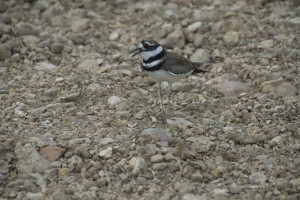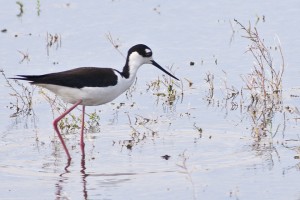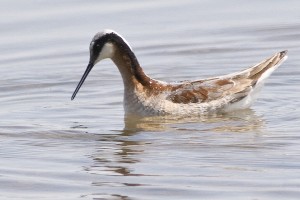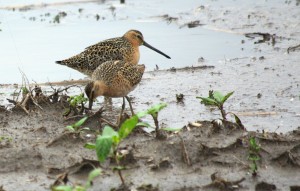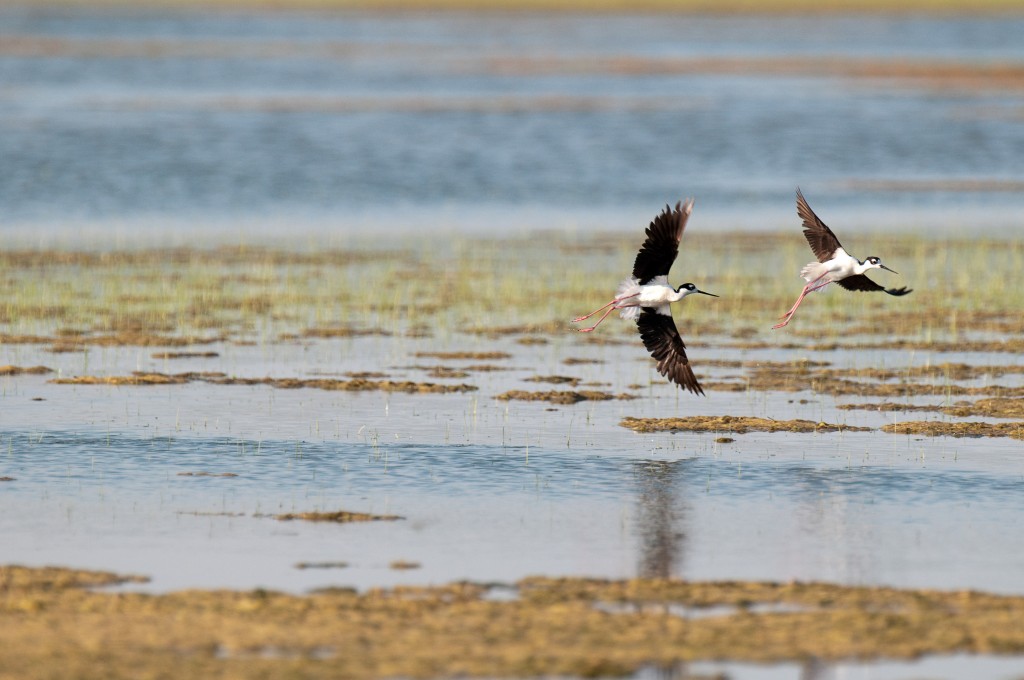“This Spring is for the (shore) Birds!”
Our very wet, rainy spring — the St. Louis Meteorological office reports that the over 25 inches of rain received so far this year, breaks all records since 1870 and is nearly 10 inches more rainfall than the average — has turned many fields into shallow pools and mud flats. An imaginative viewer can stand atop our bluff lands and look across time, seeing ancient lakes, drained for much of the last century, now lapping back at their once-upon-a-time shorelines. The lakes and marshes — sketched and named in 19th and early 20th century plat maps of Monroe and Randolph Counties — are more than old place names this year: Lakes Conner, Grand Coulee, Kidd, Masterson, Raynor, Wallace and Fish have again filled.
Although our area farmers were forced to wait, and look forward to drier days and workable fields, through mid-May others probed and plucked sustenance and life itself from the rich mud and shallow waters in the American Bottoms. “Wherever there’s something to eat, there’s something to eat it,” is, for the biological sciences, close to a truism. And this year, a plenitude of rain meant plenty to eat for plenty of shorebirds.
The general term encompasses members of several families of birds, including plovers, stilts, and sandpipers, but, despite the overall name, not all shorebirds live along the waters’ edge, including our resident plover, the Killdeer. They are diverse in
appearance, from large, long-billed and long-legged waders, to small “peep” like stubby-billed little brown birds that carom and scurry across a mud flat. Even as the diversity between family groups is characteristic, several species are so alike they are maddeningly difficult to distinguish. Many migrate vast distances each year, and nearly all have a great affinity for mud, the goopier the better.
Many species of shorebirds migrate through our area each year; this spring, several have found conditions so rewarding, the food so refreshing, that they have paused and refueled. Among these have been a few bird species that have only rarely been recorded here.
American Golden Plovers are regular early spring visitors in our area, stopping to feed and rest in fields during late March through April. But, Black-bellied Plovers also stopped by this year. They breed in the topmost stretches of the Canadian arctic and winter along the coasts of six continents. A striking study in black-and-white feathers overlaid with silver spangles, Black-bellied Plovers generally migrate well to our east.
Black-necked Stilts have been recorded in Southern Illinois only since the 1990s. This year, several small flocks in groups of up to ten individuals visited local mudflats and field pools. Elegant in black-and-white feathering, stilts teeter about on impossibly long and incredibly slender legs which are colored shocking pink. Most stilts winter along U.S. coastal areas and move to breeding areas in the inland western U.S.
Also only rarely encountered in our area and not seen since 1984, Hudsonian Godwits stopped by this year. These heavier, long-billed birds, decked out in breeding plumage of deep chestnut and streaked gray, once were thought to be on the verge of extinction. But, while indeed their populations had been reduced by market hunting in the 19th century, the small numbers of observed birds actually turned out to be the result of their usual migration pattern: nonstop flights to and from the high Arctic and Argentina in South America.
Our regular spring shorebird visitors, Greater Yellowlegs and Lesser Yellowlegs, were present this year in unusually high numbers — feeding flocks of 50 and 60 birds were spotted. Similarly, large numbers of Spotted Sandpipers, one of the few shorebirds that includes Monroe County within its breeding territory, also were sighted.
This year, joining them at pools in flooded fields were numbers of Wilson’s
Phalaropes. Like the Black-necked Stilts, these phalaropes breed near lakes and ponds in the Western U.S. and Canada. During many migrations, Wilson’s Phalaropes fly nonstop between their breeding grounds and wintering grounds in the highlands of South America.
The phalaropes and Spotted Sandpipers exhibit an interesting breeding behavior known as polyandry, a system in which females often take multiple male partners. The usual sex roles found in birds are reversed, with the females more brightly colored and larger than the males. Females also initiate courtship and may take several males as mates. In each case, after laying a clutch of eggs, the female leaves the male who then performs all incubation, nesting, and chick-rearing duties.
Yet another unusual temporary guest to our agricultural shores were Short-billed Dowitchers. Only a few spring sightings of this species have been recorded through the last thirty years. The birds that visited here were heading from their wintering grounds — probably along the Gulf Coast — towards their summer breeding range in central Canada.
All these birds, and many others, stopped by for the wealth of food made possible by the shallow standing water in our agricultural fields. They were, for the most part, as dissatisfied with the flooded wheat fields as were our area farmers, leaving those waters the exclusive domain of American Coots and Blue-winged Teal. The shorebirds poked, prodded, stirred-up, and swallowed prey in and near the pools in unplanted fields. They primarily were eating insects and insect larvae — mosquitoes, gnats, and flies for the most part — along with a few land snails and worms. Our flooded fields and the harvest of “bug bites” helped many shorebirds along their great-distance migrations and made them more capable of reproductive success at the conclusion of their long journeys.
As all of these unusual species of shorebirds stopped and briefly stayed this spring, each one gave local birders essentially “backyard” viewing of species normally seen only after the time and expense of a long-distance vacation. The muttered conversations of birders huddled in their own small flocks along Levee Road — debating bill length and degree of curve, or the amount of chestnut (or is it brown!) speckling on the flanks of a sparrow-sized puffball, only thus enlarged by the use of high-powered spotting scopes — could be taken as evidence of obsession.
After settling on an identification, “Western Sandpiper,” the birders could begin scanning yet another pool and another mudflat, for yet another species. But, first move the car — and the scopes — to get out of the way of the farmer, who is also scanning the fields and heavens, looking for drier ground and drier skies. And then, after a pleasant exchange of “good mornings,” the birders could only grin with satisfied agreement as the farmer noted with some exasperation, “This spring is for the birds.”
Clifftop, a local nonprofit organization, is focused on preserving and protecting area bluff lands.
A version of this article appeared in the June 4 2008 edition of the Monroe County Clarion.
© 2008 all content rights reserved, Clifftop NFP.
Comments are currently closed.


